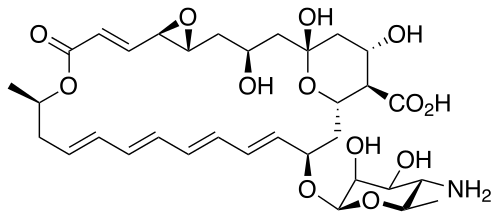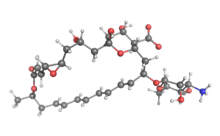Natamycin
Natamycin, also known as pimaricin, is an antifungal medication used to treat fungal infections around the eye.[1][2] This includes infections of the eyelids, conjunctiva, and cornea.[1] It is used as eyedrops.[1] Natamycin is also used in the food industry as a preservative.[2]
 | |
 | |
| Clinical data | |
|---|---|
| Trade names | Natacyn, others |
| AHFS/Drugs.com | Monograph |
| Routes of administration | Eye drops[1] |
| ATC code | |
| Identifiers | |
| |
| CAS Number | |
| PubChem CID | |
| DrugBank | |
| ChemSpider | |
| UNII | |
| KEGG | |
| ChEMBL | |
| E number | E235 (preservatives) |
| CompTox Dashboard (EPA) | |
| ECHA InfoCard | 100.028.803 |
| Chemical and physical data | |
| Formula | C33H47NO13 |
| Molar mass | 665.733 g·mol−1 |
| 3D model (JSmol) | |
| Density | 1.35 g/ml g/cm3 |
| Melting point | Darkens at ±200 °C with vigorous decomposition at 280-300 °C |
| Solubility in water | 0.39 mg/ml |
| |
| |
Allergic reactions may occur.[1] It is unclear if medical use during pregnancy or breastfeeding is safe.[1] It is in the macrolide and polyene families of medications.[1] It results in fungal death by altering the cell membrane.[1]
Natamycin was discovered in 1955 and approved for medical use in the United States in 1978.[1][2] It is on the World Health Organization's List of Essential Medicines.[3] It is produced by fermentation of certain type of the bacterium Streptomyces.[1][4]
Uses
Medical
Natamycin is used to treat fungal infections, including Candida, Aspergillus, Cephalosporium, Fusarium, and Penicillium. It is applied topically as a cream, in eye drops, or (for oral infections) in a lozenge. Natamycin shows negligible absorption into the body when administered in these ways. When taken orally, little or none is absorbed from the gastrointestinal tract, making it inappropriate for systemic infections.[5] Natamycin lozenges are also prescribed to treat yeast infections and oral thrush.[6]
Food
Natamycin has been used for decades in the food industry as a hurdle to fungal outgrowth in dairy products and other foods. Potential advantages for the usage of natamycin might include the replacement of traditional chemical preservatives, a neutral flavor impact, and less dependence on pH for efficacy, as is common with chemical preservatives. It can be applied in a variety of ways: as an aqueous suspension (such as mixed into a brine) sprayed on the product or into which the product is dipped, or in powdered form (along with an anticaking agent such as cellulose) sprinkled on or mixed into the product.
While not currently approved for use on meats in the United States, some countries allow natamycin to be applied to the surface of dry and fermented sausages to prevent mold growth on the casing. Also, natamycin is approved for various dairy applications in the United States. More specifically, natamycin is commonly used in products such as cream cheeses, cottage cheese, sour cream, yogurt, shredded cheeses, cheese slices, and packaged salad mixes. One of the reasons for food producers to use natamycin is to replace the artificial preservative sorbic acid.[7]
As a food additive, it has E number E235. Throughout the European Union, it is approved only as a surface preservative for certain cheese and dried sausage products. It must not be detectable 5 mm below the rind. While natamycin is approved in different applications at different levels in the world, it is approved in over 150 countries worldwide.[8]
The European Food Safety Authority (EFSA) panel took over the responsibilities of providing scientific food safety advice to the EU from the Scientific Committee on Food in 2002.[9] In 2009, the EFSA considered the proposed use levels of natamycin are safe if it is used for the surface treatment for these cheese and sausage types.[10]
Safety
Natamycin does not have acute toxicity. In animal studies, the lowest LD50 found was 2.5-4.5 g/kg.[11] In rats, the LD50 is ≥2300 mg/kg, and doses of 500 mg/kg/day over 2 years caused no detectable differences in survival rate, growth, or incidence of tumors. The metabolites of natamycin also lack toxicity. The breakdown products of natamycin under various storage conditions may have a lower LD50 than natamycin, but in all cases, the numbers are quite high. In humans, a dose of 500 mg/kg/day repeated over multiple days caused nausea, vomiting, and diarrhea.[12]
No evidence shows natamycin, at either pharmacological levels or levels encountered as a food additive, can harm normal intestinal flora, but definitive research may not be available.[12] However, some people are allergic to natamycin.[13]
The EFSA has concluded that the use of natamycin as a food additive has no relevant risk for the development of resistant fungi.[10]
Mechanism of action
Natamycin inhibits the growth of fungi by specifically binding to ergosterol present in fungal cell membranes. The molecule interacts irreversibly with the sterol forming a sandwich-like structure embedded in the hydrophobic core of the membrane; between the two lipid layers. This causes membrane fragmentation and indirectly affects the functions ergosterol takes part in, such as endocytosis and exocytosis, vacuole fusion, morphogenesis, and amino acid and glucose transport across the membrane.[14][15][16]
Natamycin has very low solubility in water; however, natamycin is effective at very low levels. Its minimum inhibitory concentration is less than 10 ppm for most molds.
History
It is produced as a secondary metabolite by some Streptomyces species: S. natalensis, S. lydicus, S. chattanoogensis and S. gilvosporeus.[4]
Natamycin was first isolated in 1955 from fermentation broth of a Streptomyces natalensis cell culture.[17] It was originally named pimaricin to honor Pietermaritzburg, where Streptomyces natalensis was acquired. Pimaricin was later renamed natamycin after the World Health Organization (WHO) mandated that antibiotics produced by Streptomyces end in –mycin. The name also related to the organism producing the compound, Streptomyces natalensis, hence the name natamycin.[17]
Society and culture
Natamycin appears on Whole Foods' “Unacceptable Ingredients for Food” list.[18]
References
- "Natamycin". The American Society of Health-System Pharmacists. Retrieved 8 December 2017.
- Branen, A. Larry; Davidson, P. Michael; Salminen, Seppo; Thorngate, John (2001). Food Additives. CRC Press. pp. 599–600. ISBN 9780824741709.
- World Health Organization (2019). World Health Organization model list of essential medicines: 21st list 2019. Geneva: World Health Organization. hdl:10665/325771. WHO/MVP/EMP/IAU/2019.06. License: CC BY-NC-SA 3.0 IGO.
- Aparicio, Jesús F.; Barreales, Eva G.; Payero, Tamara D.; Vicente, Cláudia M.; de Pedro, Antonio; Santos-Aberturas, Javier (29 October 2015). "Biotechnological production and application of the antibiotic pimaricin: biosynthesis and its regulation". Applied Microbiology and Biotechnology. 100 (1): 61–78. doi:10.1007/s00253-015-7077-0. PMC 4700089. PMID 26512010.
- Sweetman, S. (2004). Martindale: The Complete Drug Reference
- Virginia-Maryland Regional College of Veterinary Medicine (http://cpharm.vetmed.vt.edu/VM8784/antimicrobials/Classes/antifungals.cfm)
- Kraft cheese singles ditch artificial preservatives
- Regulatory information: www.natamycin.com
- Safety and regulation: the formal process for analyzing the test data on food additives
- Scientific Opinion on the use of natamycin (E 235) as a food additive
- Oostendorp, J.G. (1981). "Natamysin(R)". Antonie van Leeuwenhoek. 47: 170–1. doi:10.1007/bf02342201.
- Mattia, A. et al. Safety evaluation of certain food additives and contaminants: natamicin (pimaricin). WHO Food Additives Series #48.
- Natacyn Side Effects Center
- Welscher, Yvonne M. te; Napel, Hendrik H. ten; Balagué, Miriam Masià; Souza, Cleiton M.; Riezman, Howard; de Kruijff, Ben; Breukink, Eefjan (7 March 2008). "Natamycin Blocks Fungal Growth by Binding Specifically to Ergosterol without Permeabilizing the Membrane". Journal of Biological Chemistry. 283 (10): 6393–6401. doi:10.1074/jbc.M707821200. PMID 18165687.
- Van Leeuwen, M.R.; Golovina, E.A.; Dijksterhuis, J. (June 2009). "The polyene antimycotics nystatin and filipin disrupt the plasma membrane, whereas natamycin inhibits endocytosis in germinating conidia of". Journal of Applied Microbiology. 106 (6): 1908–1918. doi:10.1111/j.1365-2672.2009.04165.x.
- te Welscher, YM; van Leeuwen, MR; de Kruijff, B; Dijksterhuis, J; Breukink, E (10 July 2012). "Polyene antibiotic that inhibits membrane transport proteins". Proceedings of the National Academy of Sciences of the United States of America. 109 (28): 11156–9. doi:10.1073/pnas.1203375109. PMC 3396478. PMID 22733749.
- “Pimaricin, a new antifungal antibiotic” in Antibiotics Annual in 1957. Natamycin VGP (http://www.natamycinvgp.com/the-origins-of-natamycin/#prettyPhoto)
- Unacceptable Ingredients for Food (http://www.wholefoodsmarket.com/about-our-products/quality-standards/food-ingredient)
External links
- Natacyn Side Effects Center
- "Natamycin". Drug Information Portal. U.S. National Library of Medicine.